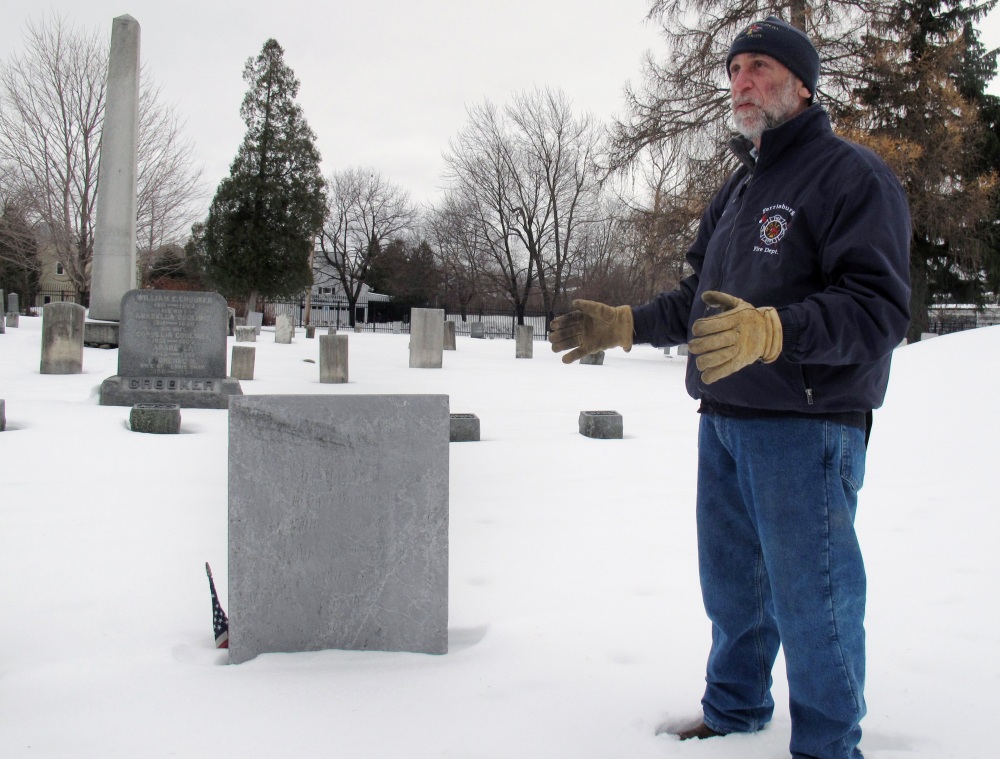BURLINGTON, Vt. —The final resting place of a little-remembered, but crucial hero of the War of 1812 lies near the waterfront in Burlington’s Elmwood Cemetery, a grave that was dug up nearly a century after his death to settle a fight over where he was buried.
What was never in dispute was that Joseph Barron Jr.’s knowledge of Lake Champlain helped the American fleet under Commodore Thomas Macdonough defeat a British force off Plattsburgh, New York, on Sept. 11, 1814. The victory helped lead to the end of the war, which resulted in a treaty signed 200 years ago Wednesday in Ghent, Belgium.
Barron, thought to be in his mid-20s at the time of his death, was Macdonough’s pilot, given the job because of his intimate knowledge of the lake’s winds, shoals, islands and bays. He was killed after the battle ended when a musket ball, apparently fired from a retreating British vessel, hit him in the head.
It’s less clear what happened to Barron after he was hit, whether he died instantly or lingered mortally wounded until his death – either in his native Vermont or across the lake in New York. To further complicate the issue, headstones still mark his final resting place in Burlington and in Plattsburgh’s Riverside Cemetery.
Around the turn of the 20th century, descendants of the war’s veterans from both sides of the lake tried to claim credit for hosting Barron’s grave. The debate became so fierce that in 1906, the Burlington grave was dug up, said Art Cohn, the director emeritus of the Lake Champlain Maritime Museum, who stumbled onto the story while researching the 200th anniversary of the Battle of Plattsburgh.
The dispute between the New York-based Sons of the War of 1812 and Vermont’s Daughters of the War of 1812 was well-covered in local newspapers of the day.
“There was some pride, belief, that their state was the repository of these important, noble remains,” Cohn said. “The fact that there were two stones made them rivals.”
Cohn found letters that describe Barron as a son of Ferrisburgh’s Basin Harbor married to a local woman who feared for his life when he went off to war.
Barron had been hired by Macdonough as the pilot for his flagship Saratoga, which led the American force set up in Cumberland Bay to stop a British naval force that was sailing south out of Canada while a ground force attacked Plattsburgh from the north.
Cohn believes Macdonough positioned his ships with Barron’s help in such a way that he defeated the British force on the lake while the land force was beat back. The American victory is said to have played a key role in the negotiations that led to the end of the war.
Cohn is unsure how long the issue over Barron’s final resting place simmered before that October day in 1906 when the Burlington grave was dug up in front of dignitaries and medical professionals.
“There at the bottom of that grave, they come upon what is conclusively identified – without DNA, obviously – as the remains of the pilot,” Cohn said.
The grave included remnants of a military uniform with brass buttons, and the injuries to the skull were consistent with the head wound known to have killed Barron.
Yet there is still a headstone with Barron’s name on it in Plattsburgh near the graves of a number of American and British officers killed during the battle.
Plattsburgh city historian John Krueger said he was aware of the 19th-century debate over the location of Barron’s grave, but he deferred to Cohn for any modern interpretation. He said he wasn’t aware of anyone who still thought Barron’s remains were in New York.
“The bicentennial has come and gone and most people are never going to think of the Battle of Plattsburgh again,” Krueger said.
Send questions/comments to the editors.



Success. Please wait for the page to reload. If the page does not reload within 5 seconds, please refresh the page.
Enter your email and password to access comments.
Hi, to comment on stories you must . This profile is in addition to your subscription and website login.
Already have a commenting profile? .
Invalid username/password.
Please check your email to confirm and complete your registration.
Only subscribers are eligible to post comments. Please subscribe or login first for digital access. Here’s why.
Use the form below to reset your password. When you've submitted your account email, we will send an email with a reset code.